In a special exhibit to open this summer, the Philadelphia Museum of Art will display the comprehensive plan that Frank Gehry has created for the renovation and expansion of its home on the Benjamin Franklin Parkway.
Museum officials recently released renderings of Gehry's final design, which reorganizes and expands the building, adding more than 169,000 sf of space. The project will ultimately transform the interior of one of the city’s most iconic buildings, enabling the museum to display much more of its world-renowned collection.
Gehry’s design focuses on the transformation of the interior of the Museum through the renovation of beloved spaces such as the Great Stair Hall and major improvements to how visitors will enter and move through the building. The design also calls for the creation of a significant amount of new space for expanded educational activities and the display of the museum’s extensive holdings of American, Asian, and modern and contemporary art in new galleries created both within the existing building and underneath the East Terrace.
"We began by studying the character of this wonderful building—its DNA, so to speak. It is rare to have the bones of the existing building show you the way to expand it," said Gehry. "From there, we used the significant assets that the original architects gave us to create a strong entry sequence and circulation pattern that connects the new galleries to the existing building in a way that makes the new galleries seem like they have always been there. My goal is to make the building feel like one coherent design statement."
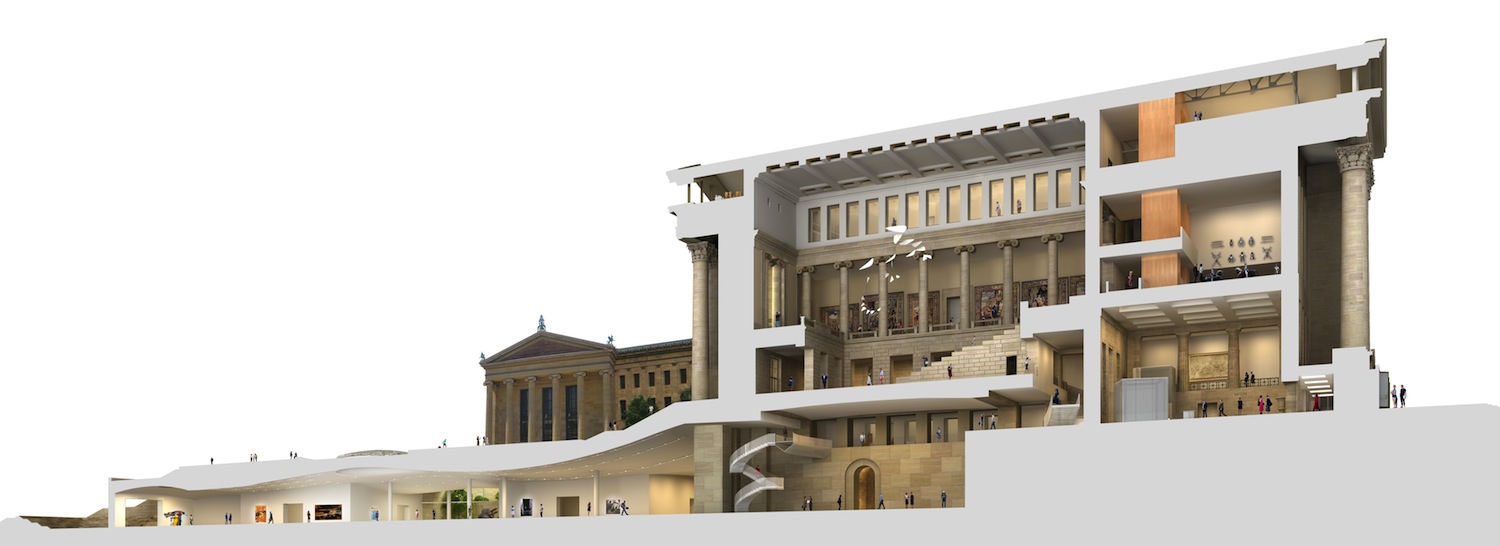
A cross-section view showing the changes to existing interior spaces and the new underground galleries. Rendering: Gehry Partners
Given the prominence of the Museum’s main building as a landmark, minimal changes have been proposed for the exterior by Gehry Partners and OLIN, the noted Philadelphia firm specializing in landscape architecture, planning, and urban design. These changes include:
• The redesign of the plaza in front of the west entrance and the landscaping of a substantial portion of the area now used for parking on this side of the building.
• The integration of skylights and sunken gardens into the east terrace to bring natural light into the new galleries that have been proposed.
• The addition on the northeast and southeast corners of the building of stair enclosures that will be simple in form and clad in the same sandstone used on the exterior in order to be as unobtrusive as possible.
By contrast, many significant changes have been proposed for the interior, yielding an increase of 124,000 sf of public space, including 78,000 sf of gallery space throughout the building. Other changes address access and circulation through the varying “ground” levels of the facility.
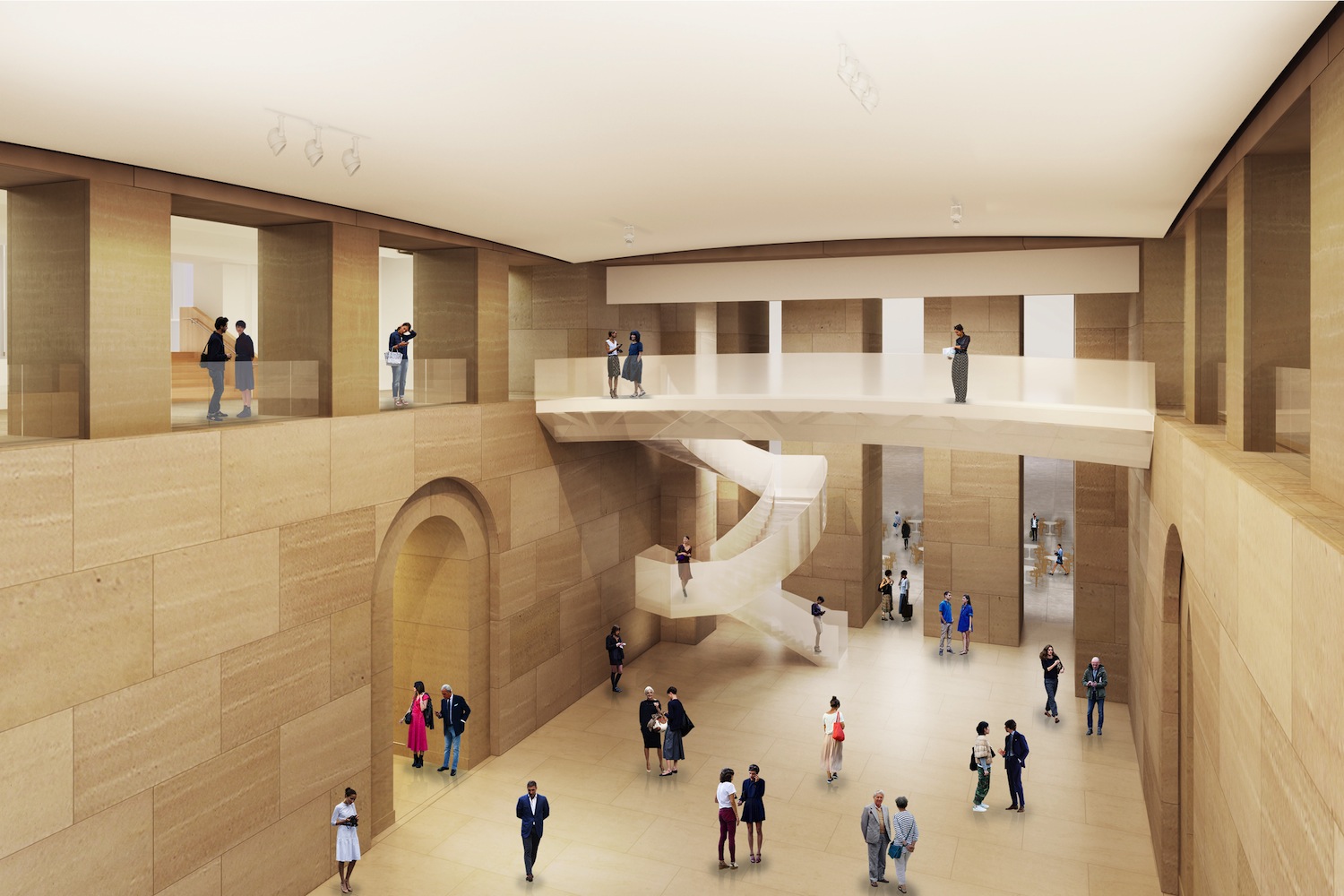
Forum Gallery: The heart of the museum will be opened up, creating a clear sight line through the ground-floor and first-floor galleries that will greatly simplify wayfinding. Rendering: Gehry Partners
At present, visitors enter the museum on the first floor through the east entrance and the Great Stair Hall or on the slightly lower floor through the west entrance and Lenfest Hall. The Gehry design will open new spaces to explore, such as the Forum and new galleries under the East Terrace.
Among the interior changes are:
• The renovation of the two principal public entrance spaces in the museum: Lenfest Hall and the Great Stair Hall.
• The creation of a new public space, or Forum, immediately below the Great Stair Hall in the center of the U-shaped Museum building. The forum will dramatically improve circulation on this floor and open up the east-west axis at the center of the building, enabling visitors to reach the new galleries and adjacent public spaces that Gehry Partners have proposed be built below the East Terrace.
• The relocation of a variety of back-office functions to add nearly 23,000 sf of new gallery space within the existing building; the creation of a new 10,000-sf education center; and the development of new visitor amenities, including a restaurant, café, and spaces for the museum store.
• The creation of 55,000 sf of new space for the presentation of special exhibitions and works from the collection in galleries underneath the east terrace. Ranging in height from 24 to 28 feet, with a vaulted ceiling supported on slender columns, these new galleries will be among the largest and most spacious in the entire Museum. Open in plan and filled with natural light, they will provide an ideal setting for the display of modern and contemporary art.
• The reopening of a public entrance on the north side of the museum. Closed to the public since the 1970s, this monumental arched entrance adjacent to Kelly Drive will be renovated to provide access to a grand vaulted corridor—part of the original design of the building—that runs 640 feet from the north to the south side of the building. This walkway will provide access to the new galleries through a long, vaulted arcade and will intersect with the new Forum directly below the Great Stair Hall, thus providing access to the entire building for visitors entering on this level.
• A new 299-seat auditorium equipped for lectures, performances, and public events, to be located underneath the northwest terrace of the main building and directly accessible from the new public entrance facing Kelly Drive.
• The adaptation of the center portion of the top floor of the U-shaped Museum building to create meeting and event spaces, and the replacement of the brick in the pediments with glass to provide dramatic views of the city and Fairmount Park.
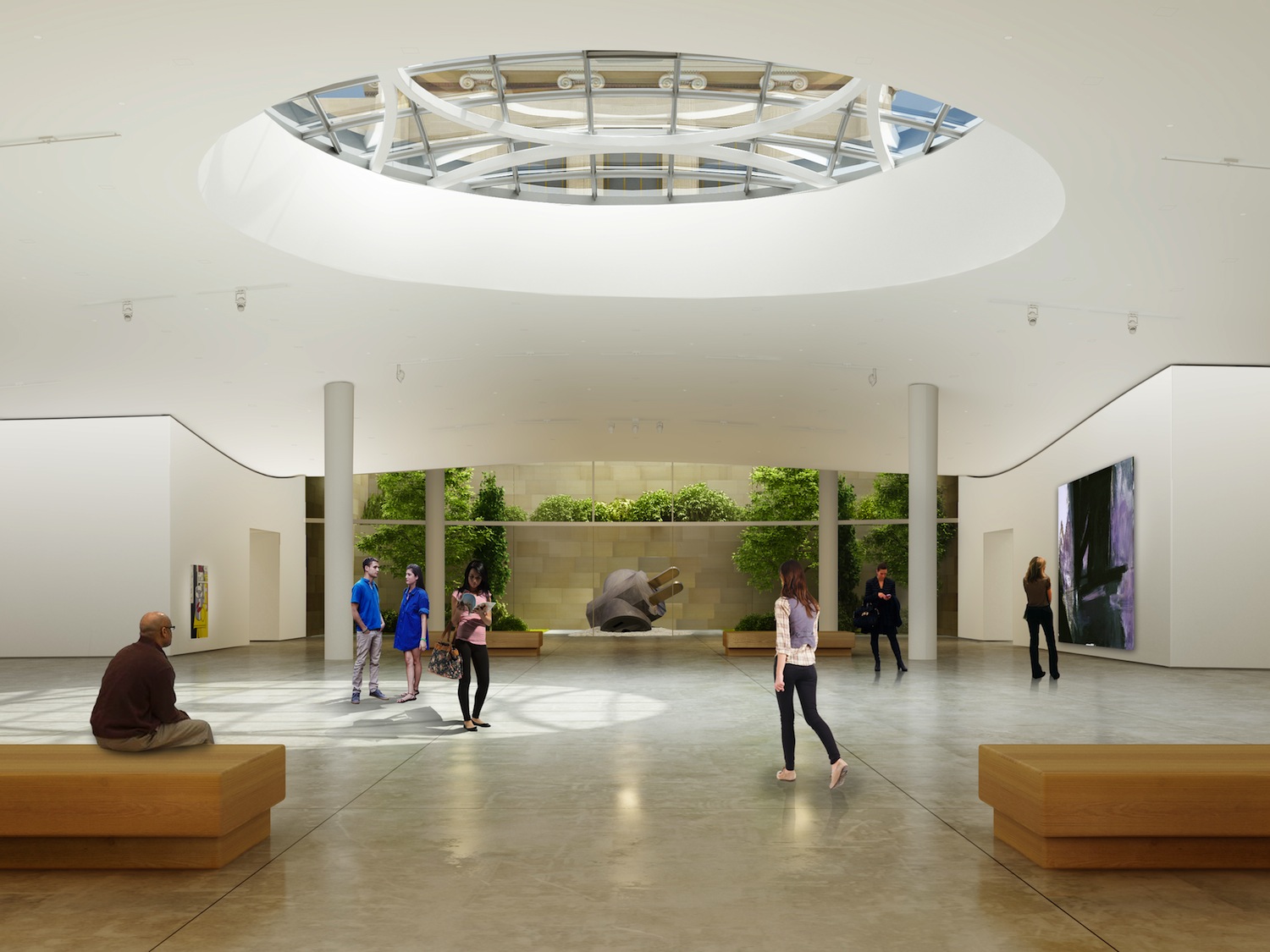
Level C Galleries: The new underground galleries will be lit in part by a skylight in the East Terrace. Rendering: Gehry Partners
“Given the ambitious scope of the plan, it has been designed in separate phases that can be implemented as funds become available," said Gail Harrity, the Museum’s President and COO. "This work must begin with—and be sustained by—an inspiring and persuasive vision of the future, recognizing that it will take years to implement the brilliant plan developed by Frank Gehry and his partners.”
The Building Team includes:
Architects: Gehry Partners, LLP, OLIN
Structural/civil engineer: Magnusson Klemenic Associates
MEP engineer: AltieriSeborWieber
BIM consultant: Gehry Technologies Inc.
Life safety/fire protection: Hughes Associates
Lighting consultant: L’Observatoire
Daylighting consultant: Loisos + Ubbelohde Associates
Theater/AV consultant: Auerbach Pollock Friedlander
Specification writer: CG Associates
Environmental design engineering: Atelier Ten
Waterproofing consultant: Henshell & Buccellato, Consulting Architects
Acoustical engineer: Cerami & Associates
IT/AV consultant: Shen Milsom & Wilke
Security consultant: Ducibella, Venter & Santore
Vertical transportation: Lerch Bates, Inc.
Exterior enclosure: Gordon H. Smith Corporation
Urban design: Urban Strategies Inc/JZTI
Historic preservation architect: Kelly/Maiello Inc.
Cost estimation: AECOM
Site survey: Pennoni Associates Inc.
Geotechnical engineering: Haley & Aldrich
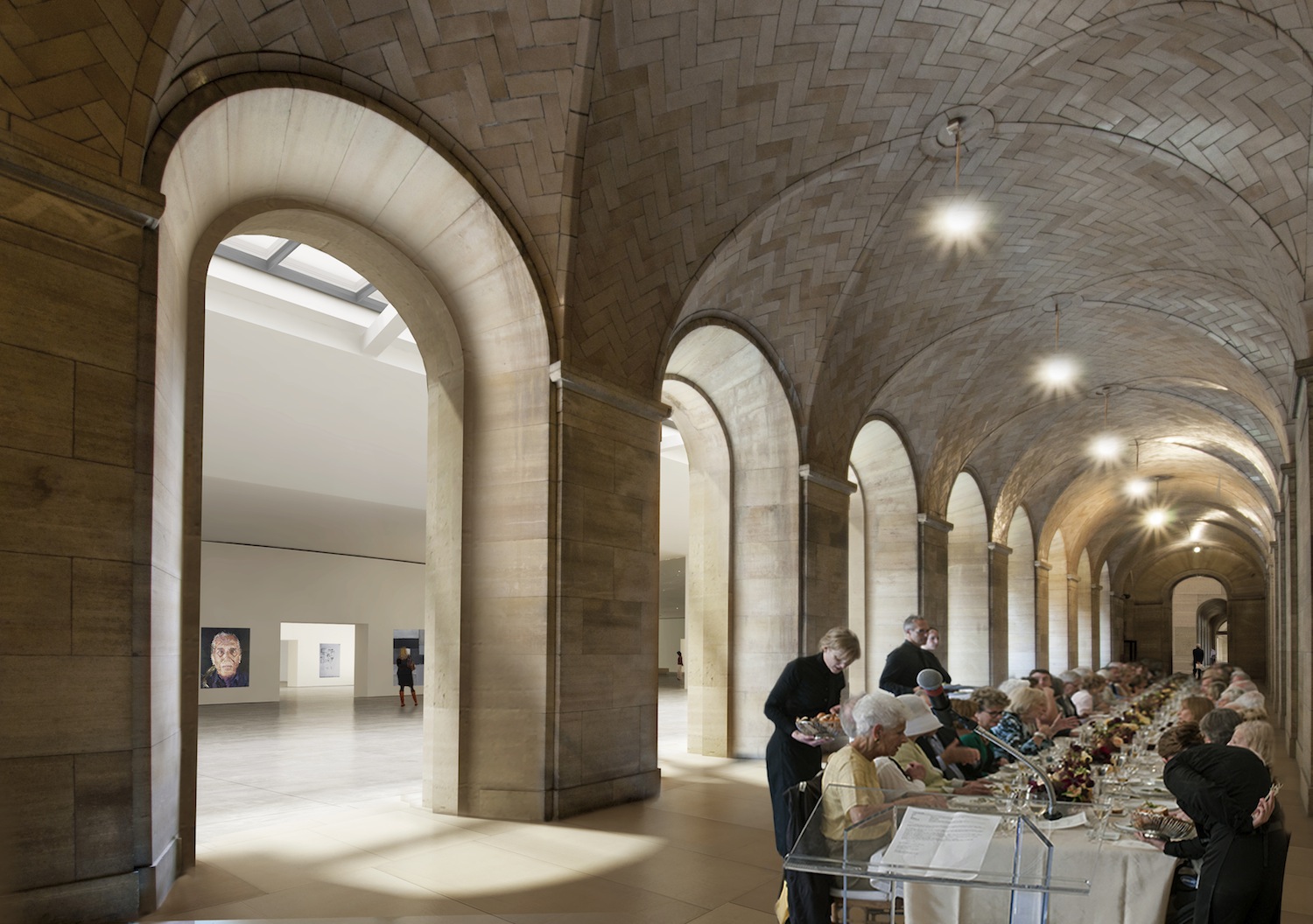
Vaulted Walkway: The vaulted underground walkway, long closed to visitors, will become a space for art and events, with entrances at the north (Kelly Drive) and south (Schuylkill River) sides of the building. Rendering: Gehry Partners
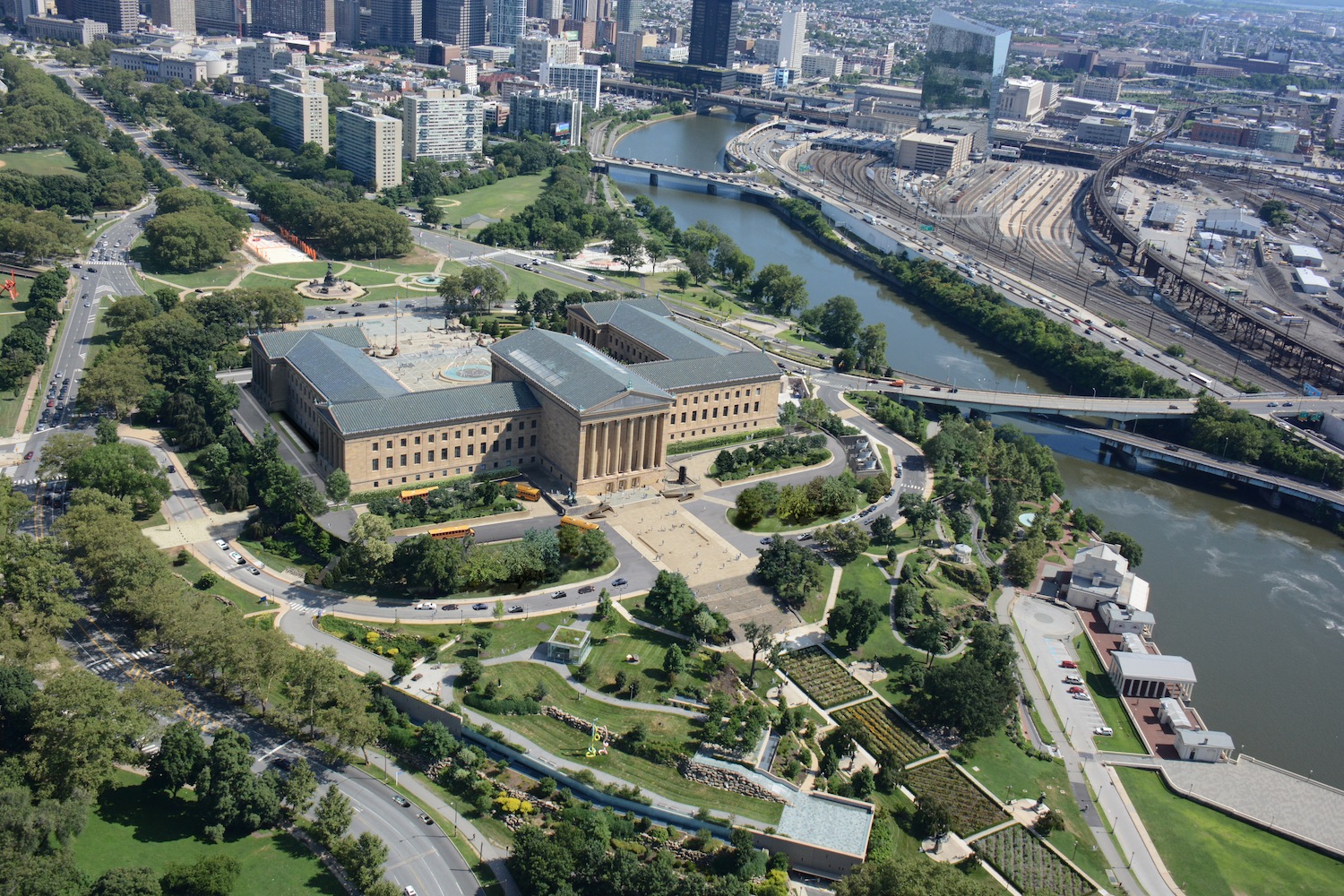
West Terrace. Rendering: Gehry Partners
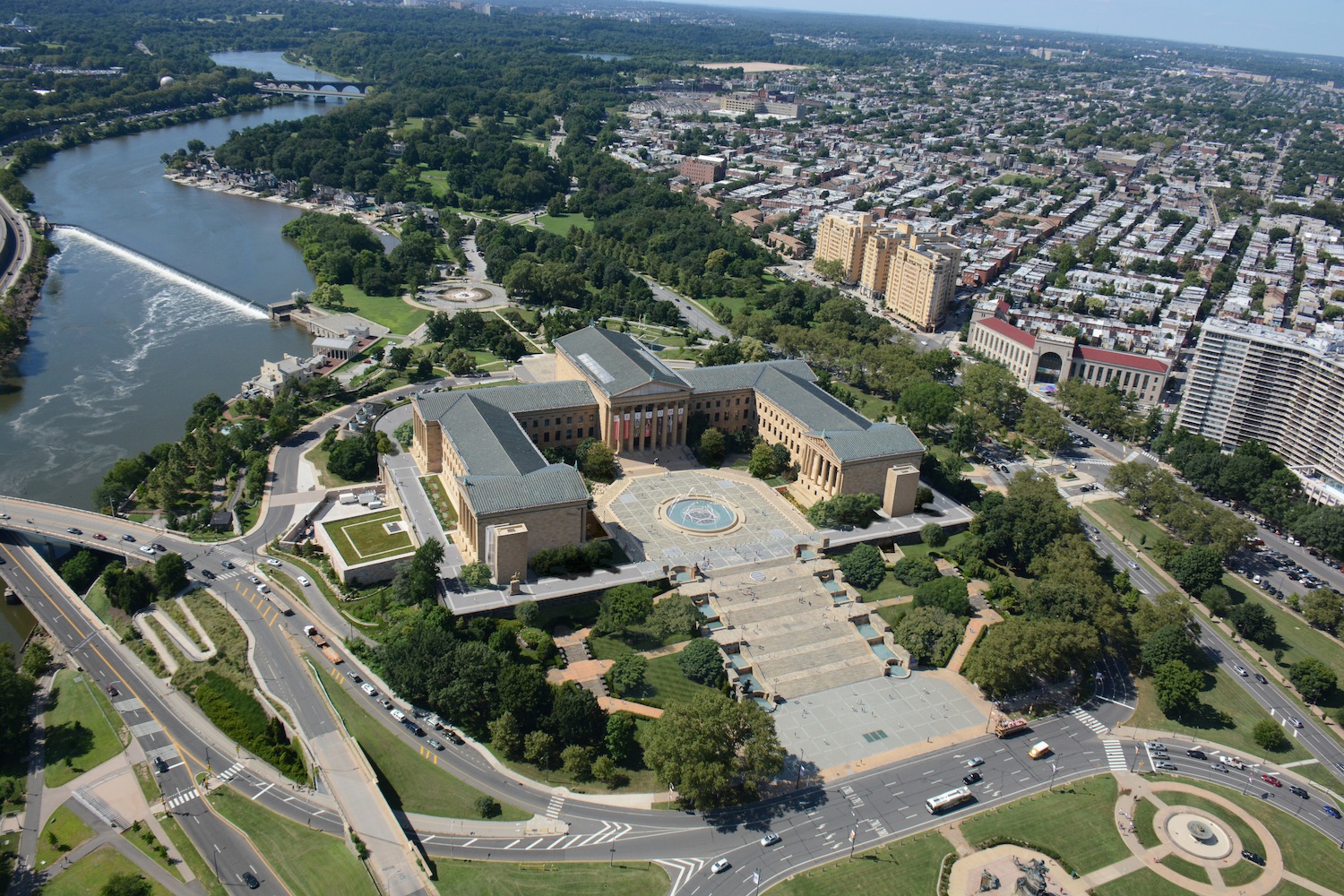
East Terrace with famed "Rocky steps." Rendering: Gehry Partners
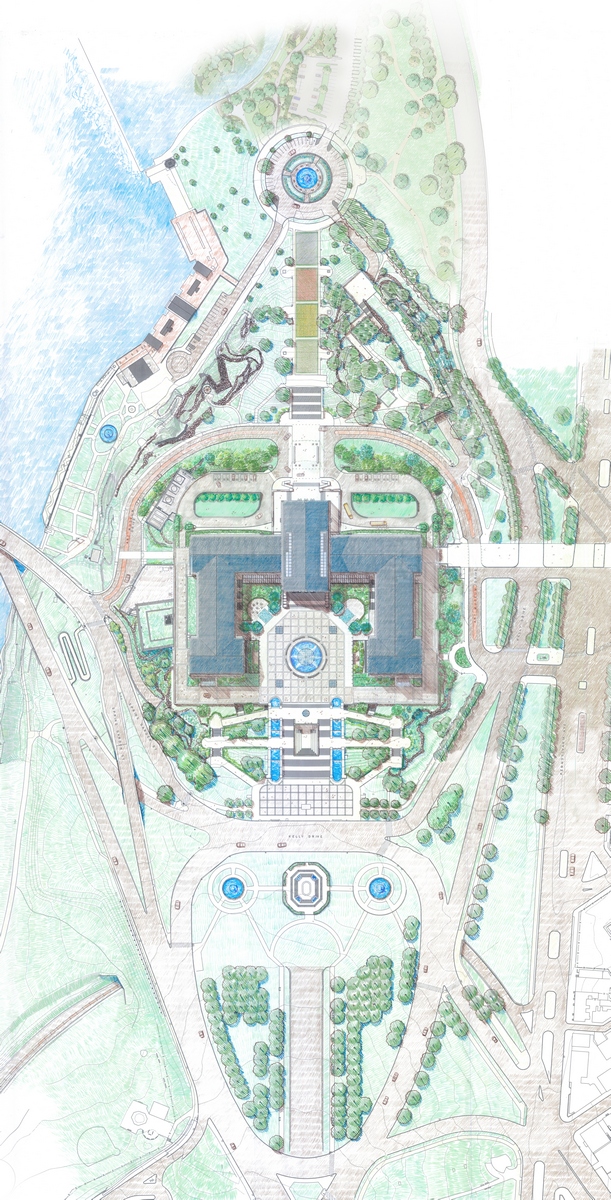
PMA Rendered Plan, OLIN
Related Stories
| Aug 11, 2010
ZweigWhite names its fastest-growing architecture, engineering, and environmental firms
Management consulting and research firm ZweigWhite has identified the 200 fastest-growing architecture, engineering, and environmental consulting firms in the U.S. and Canada for its annual ranking, The Zweig Letter Hot Firm List. This annual list features the design and environmental firms that have outperformed the economy and competitors to become industry leaders.
| Aug 11, 2010
SSOE, Fluor among nation's largest industrial building design firms
A ranking of the Top 75 Industrial Design Firms based on Building Design+Construction's 2009 Giants 300 survey. For more Giants 300 rankings, visit http://www.BDCnetwork.com/Giants
| Aug 11, 2010
Guggenheim to host live online discussion of Frank Lloyd Wright exhibition
The Solomon R. Guggenheim Museum launches the Guggenheim Forum, a new series of moderated online discussions among experts from a variety of fields that will occur in conjunction with major museum exhibitions.
| Aug 11, 2010
Best AEC Firms of 2011/12
Later this year, we will launch Best AEC Firms 2012. We’re looking for firms that create truly positive workplaces for their AEC professionals and support staff. Keep an eye on this page for entry information. +
| Aug 11, 2010
Report: Building codes and regulations impede progress toward uber-green buildings
The enthusiasm for super green Living Buildings continues unabated, but a key stumbling block to the growth of this highest level of green building performance is an existing set of codes and regulations. A new report by the Cascadia Region Green Building Council entitled "Code, Regulatory and Systemic Barriers Affecting Living Building Projects" presents a case for fundamental reassessment of building codes.
| Aug 11, 2010
Call for entries: Building enclosure design awards
The Boston Society of Architects and the Boston chapter of the Building Enclosure Council (BEC-Boston) have announced a High Performance Building award that will assess building enclosure innovation through the demonstrated design, construction, and operation of the building enclosure.
| Aug 11, 2010
Portland Cement Association offers blast resistant design guide for reinforced concrete structures
Developed for designers and engineers, "Blast Resistant Design Guide for Reinforced Concrete Structures" provides a practical treatment of the design of cast-in-place reinforced concrete structures to resist the effects of blast loads. It explains the principles of blast-resistant design, and how to determine the kind and degree of resistance a structure needs as well as how to specify the required materials and details.







